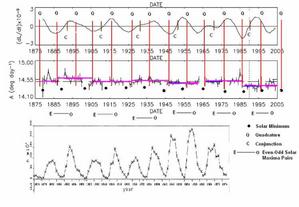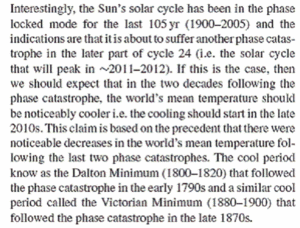オーストラリア天文学会員の地球寒冷化説
池田信夫 blog:温暖化懐疑論のまとめで紹介されているオーストラリア天文学会の論文(以前のエントリーのコメント欄でも紹介されていた)Does a Spin–Orbit Coupling Between the Sun and the Jovian Planets Govern the Solar Cycle?。
本文読むとカネもかかるし、手続きも面倒なのでメールで「これから寒冷化するの?」と問い合わせたら、著者の1人、Dr. Ian Wilsonから返信が来た。英語サイトにも似たようなDr. Wilsonの回答がアップされているので、これは個人宛というより、FAQを想定したテンプレート回答のようなものなので紹介する。
以下がメールと添付されたグラフと結論部分。
 Below are a series of graphs that highlight many of the points made in our PASA paper. The top graph shows derivative of the angular-momentum of the Sun about the centre of mass of the solar system between 1875 and 2005.
Below are a series of graphs that highlight many of the points made in our PASA paper. The top graph shows derivative of the angular-momentum of the Sun about the centre of mass of the solar system between 1875 and 2005.
The second graph shows the mean equatorial rotation rate of the Sun. Superimposed on each of these are the times conjunction (C) (i.e. when Jupiter and Saturn are on opposites sides of the Sun) and first and third quadrature.
You can see from these graphs that every time the first quadrature of JS is ahead of the nearest minimum in dL/dT, the mean equatorial rotation rate of the Sun (A) goes up and every time the first quadrature of JS is behind the nearest minimum in dL/dT, it goes down. For reference, I have added a plot of the annual sunspot number (SSN) below these two graphs with even (E) and odd (O) identified. The absence of solar rotation data at the solar minima (black dots) is my doing, as the rotation rate is poorly determined and spikes at these times. Interestingly, all else being equal (i.e. our prediction may be affected by a phase-catastrophe in the next decade), we would predict that the mean equatorial rotation rate of the Sun should increase once we have moved away from solar minimum in 2010.
最初にBelowとあるのは、ここでは左のグラフのこと。
 And yes our paper concludes:(⇒)
And yes our paper concludes:(⇒)
Dr. Ian Wilson
Mark Twain famously concluded, “There is something fascinating about science. One gets such wholesale returns of conjecture from such a trifling investment of fact.”
マーク・トウェーンの有名な言葉を引用しておられるのが奥ゆかしい。
やたら天文学の専門用語が散りばめられて難しく、大雑把な理解だが、要約すると、太陽系の重心(太陽、惑星、その他全部含めた重心)は巨大惑星の木星と土星の位置関係で循環的に変動し、それが太陽の赤道付近の角速度と太陽内の対流圏に影響し、太陽のエネルギー強度の周期がほぼ決まるということらしい。
木星の公転周期約12年、土星の公転周期約30年なので、木星―太陽―土星と直列する(conjunction)周期は約20年。この場合は重心がもっとも安定するはず。逆に太陽―木星―土星と直列すると、重心が偏ることになる。
とは言っても、太陽系の質量のほとんどは太陽。太陽1.989×10kgの30乗、木星 1.899×10kgの27乗、土星5.688×10kgの26乗。太陽と木星では3乗の違いがあるので、木星は太陽の1000分の1。0.1%だ。土星に至っては更に小さい。確かに影響はあるが、距離も随分離れていて、引力は距離の2乗に反比例することを考えると、誤差の範囲としか言いようがない。あまり言うと何だが惑星直列には、
惑星が一直線に並ぶと多くの惑星の総合された重力が太陽に異変を起こし、地球にもその影響が及ぶとの説が唱えられ、話題になることがある。しかし、惑星の重力の影響は取るに足りないもので、いかに多くの惑星を集めたとしてもその影響は微々たるものである。 実際に1982年に起きた例では社会現象ともなったが、もちろん現実には何も起こらなかった。惑星の特殊な並びに天の意味を見出そうとする考え方は、むしろ占星術に近い。
とある。これもそうだとは言わないけれど、洞爺湖サミットのような政治的イベントの前には玉石混交で色々な話が出て来るものだ。
Dr. Ian Wilsonは、
The absence of solar rotation data at the solar minima (black dots) is my doing, as the rotation rate is poorly determined and spikes at these times.
と一部データの不完全を認めているが、それはともかく、結論にあるようにDalton Minimumのような寒冷期がもし本当に来るなら人類には僥倖だと思う。なぜなら向こう20年か30年くらい温暖化が止まるのなら(多分、二酸化炭素濃度の増大で、あったとしても、Dalton Minimumほど下がらず、ある程度相殺する程度だろう)その間に地球温暖化対策を行えば、次の温暖化のピークに備えられる。つまり50年後くらいか。それまで何の対策もせずに二酸化炭素増大を放置すれば、本当にヤバイことになる。
基本的に太陽系内の重心の循環は繰り返されるわけで、「これから冬になりますから温暖化は止まります」と言っているに等しいわけだから。次の更に酷暑になるであろう夏に備えよう、がこの論文の真の教訓だろう。
Clickで救えるblogがある⇒![]()
![]()